Lead and Manage Organisational Change Report - Samson Media Case Study
VerifiedAdded on 2022/10/01
|18
|3340
|104
Report
AI Summary
This report provides a comprehensive analysis of the organisational change implemented at Samson Media, a publishing company facing challenges due to e-commercialisation. The report begins with an overview of Samson Media's operational functions and proposes strategic change policies. It includes an examination of the company's objectives and the need for strategic changes, followed by an analysis of existing human resource policies and procedures. A PESTLE analysis is conducted to assess the external environment, and operational changes are suggested. The report then explores best-practice change management models, cost-benefit analysis, communication and education strategies, and risk assessments. A detailed change management plan is presented, including a human resource brief and an email to staff. The report concludes with a review of the change management process and references used.
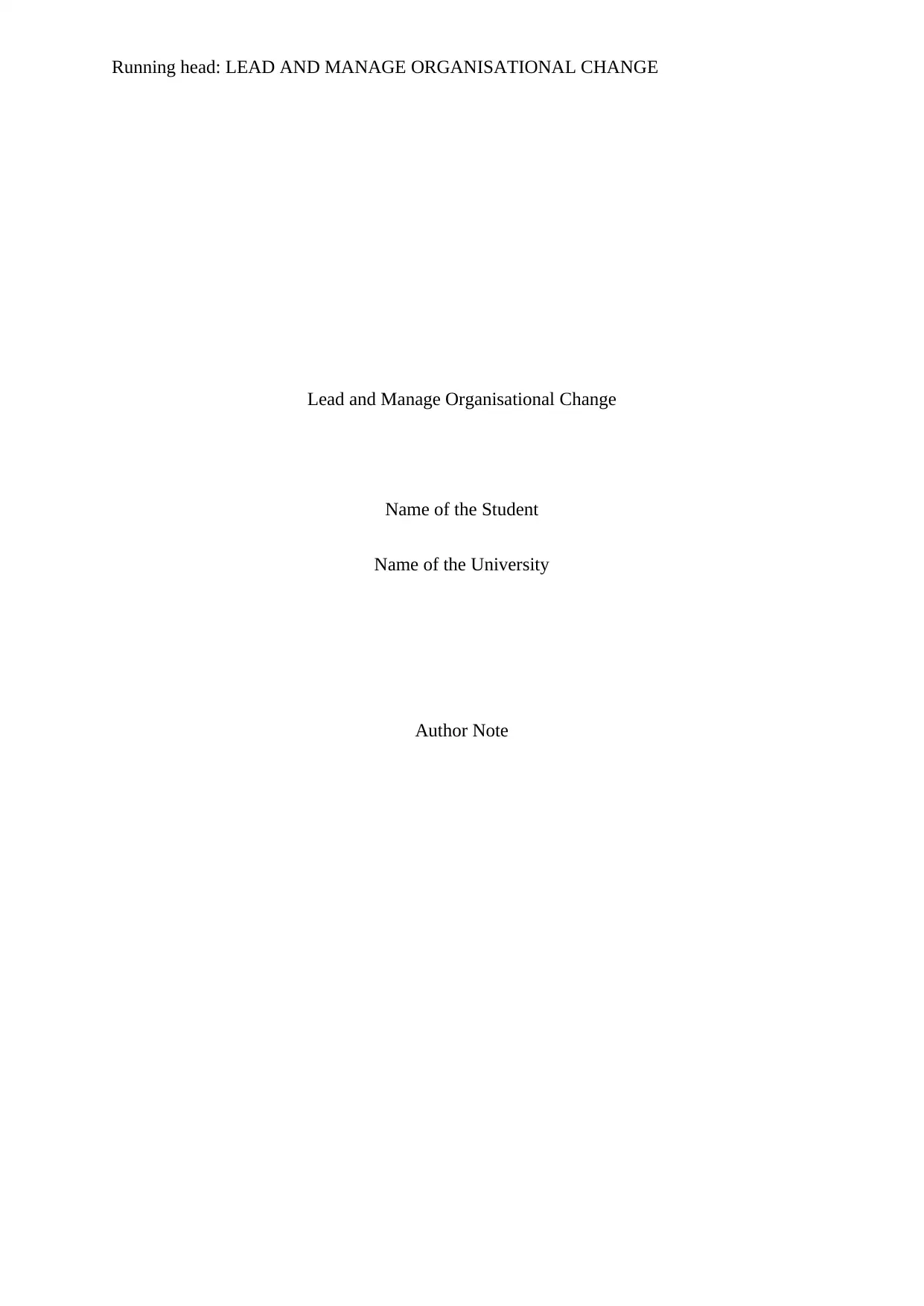
Running head: LEAD AND MANAGE ORGANISATIONAL CHANGE
Lead and Manage Organisational Change
Name of the Student
Name of the University
Author Note
Lead and Manage Organisational Change
Name of the Student
Name of the University
Author Note
Paraphrase This Document
Need a fresh take? Get an instant paraphrase of this document with our AI Paraphraser
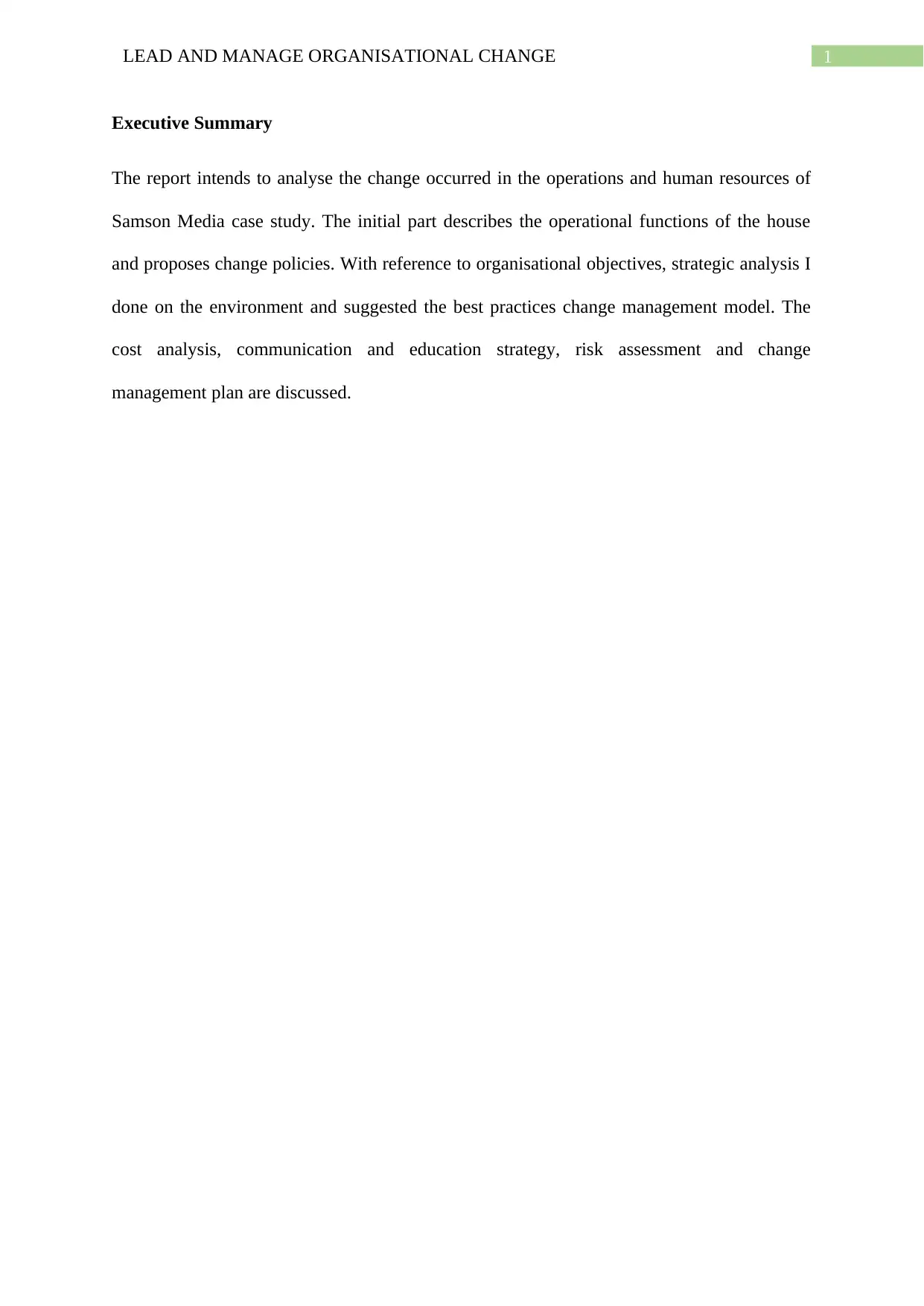
1LEAD AND MANAGE ORGANISATIONAL CHANGE
Executive Summary
The report intends to analyse the change occurred in the operations and human resources of
Samson Media case study. The initial part describes the operational functions of the house
and proposes change policies. With reference to organisational objectives, strategic analysis I
done on the environment and suggested the best practices change management model. The
cost analysis, communication and education strategy, risk assessment and change
management plan are discussed.
Executive Summary
The report intends to analyse the change occurred in the operations and human resources of
Samson Media case study. The initial part describes the operational functions of the house
and proposes change policies. With reference to organisational objectives, strategic analysis I
done on the environment and suggested the best practices change management model. The
cost analysis, communication and education strategy, risk assessment and change
management plan are discussed.
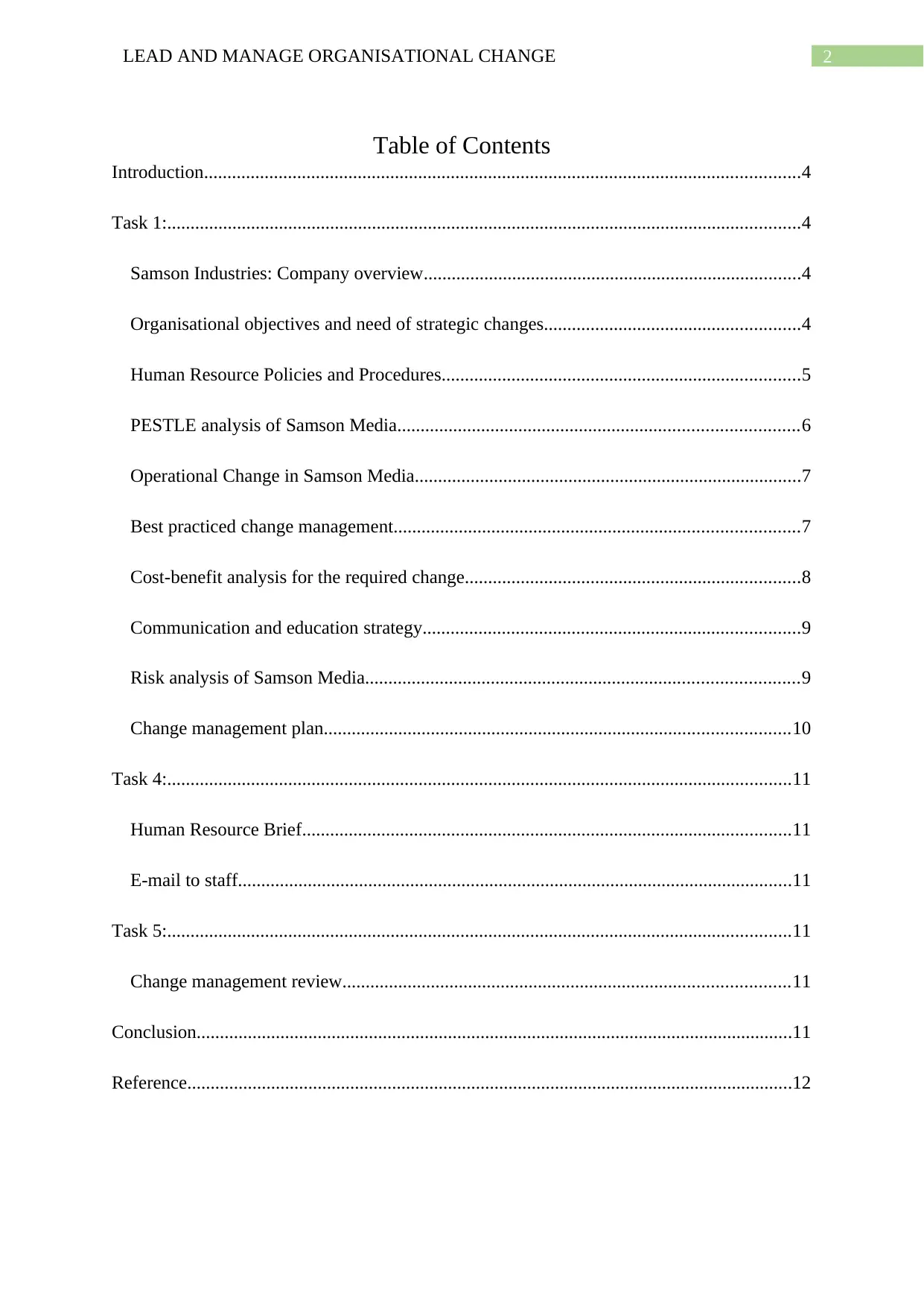
2LEAD AND MANAGE ORGANISATIONAL CHANGE
Table of Contents
Introduction................................................................................................................................4
Task 1:........................................................................................................................................4
Samson Industries: Company overview.................................................................................4
Organisational objectives and need of strategic changes.......................................................4
Human Resource Policies and Procedures.............................................................................5
PESTLE analysis of Samson Media......................................................................................6
Operational Change in Samson Media...................................................................................7
Best practiced change management.......................................................................................7
Cost-benefit analysis for the required change........................................................................8
Communication and education strategy.................................................................................9
Risk analysis of Samson Media.............................................................................................9
Change management plan....................................................................................................10
Task 4:......................................................................................................................................11
Human Resource Brief.........................................................................................................11
E-mail to staff.......................................................................................................................11
Task 5:......................................................................................................................................11
Change management review................................................................................................11
Conclusion................................................................................................................................11
Reference..................................................................................................................................12
Table of Contents
Introduction................................................................................................................................4
Task 1:........................................................................................................................................4
Samson Industries: Company overview.................................................................................4
Organisational objectives and need of strategic changes.......................................................4
Human Resource Policies and Procedures.............................................................................5
PESTLE analysis of Samson Media......................................................................................6
Operational Change in Samson Media...................................................................................7
Best practiced change management.......................................................................................7
Cost-benefit analysis for the required change........................................................................8
Communication and education strategy.................................................................................9
Risk analysis of Samson Media.............................................................................................9
Change management plan....................................................................................................10
Task 4:......................................................................................................................................11
Human Resource Brief.........................................................................................................11
E-mail to staff.......................................................................................................................11
Task 5:......................................................................................................................................11
Change management review................................................................................................11
Conclusion................................................................................................................................11
Reference..................................................................................................................................12
⊘ This is a preview!⊘
Do you want full access?
Subscribe today to unlock all pages.

Trusted by 1+ million students worldwide
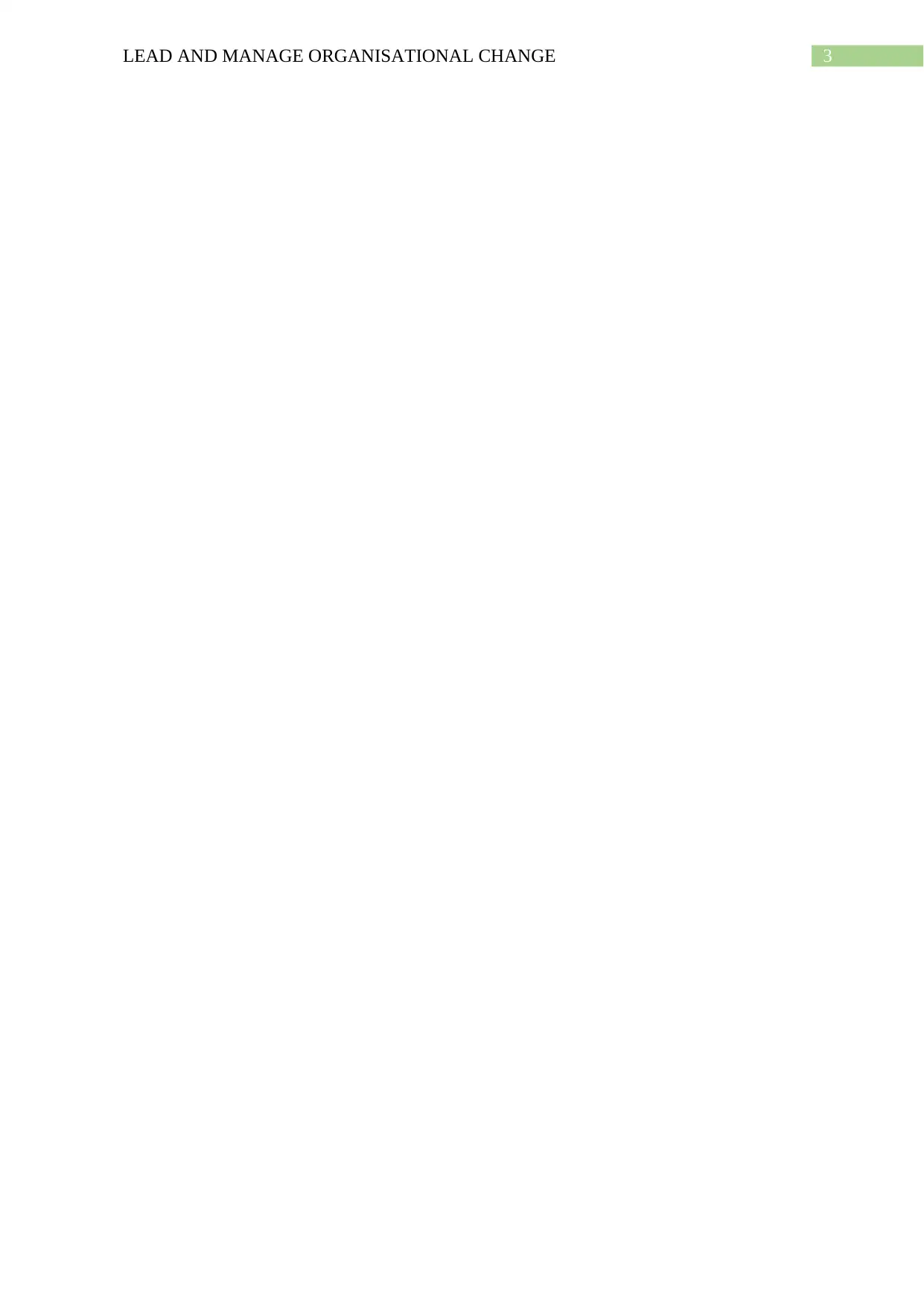
3LEAD AND MANAGE ORGANISATIONAL CHANGE
Paraphrase This Document
Need a fresh take? Get an instant paraphrase of this document with our AI Paraphraser
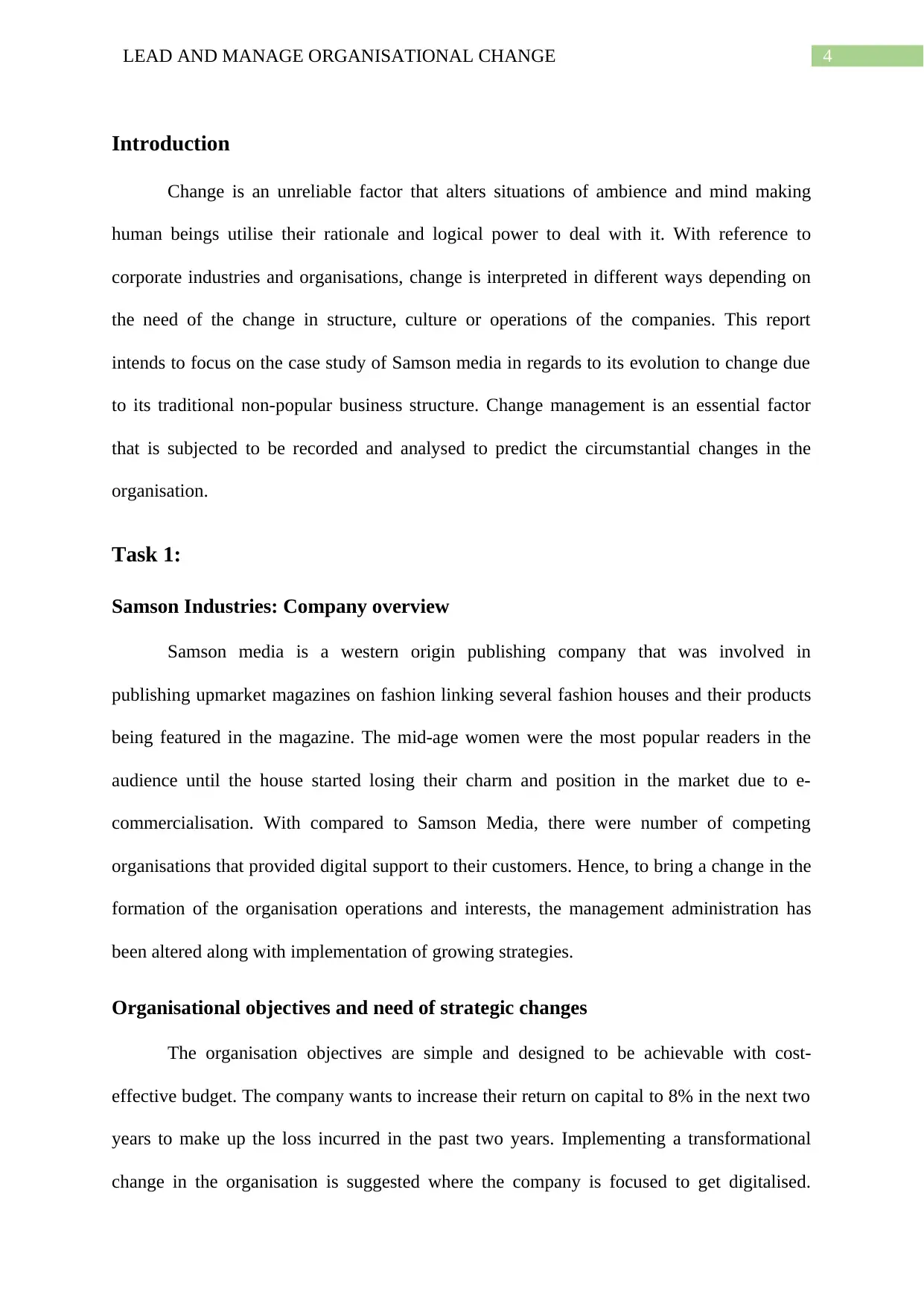
4LEAD AND MANAGE ORGANISATIONAL CHANGE
Introduction
Change is an unreliable factor that alters situations of ambience and mind making
human beings utilise their rationale and logical power to deal with it. With reference to
corporate industries and organisations, change is interpreted in different ways depending on
the need of the change in structure, culture or operations of the companies. This report
intends to focus on the case study of Samson media in regards to its evolution to change due
to its traditional non-popular business structure. Change management is an essential factor
that is subjected to be recorded and analysed to predict the circumstantial changes in the
organisation.
Task 1:
Samson Industries: Company overview
Samson media is a western origin publishing company that was involved in
publishing upmarket magazines on fashion linking several fashion houses and their products
being featured in the magazine. The mid-age women were the most popular readers in the
audience until the house started losing their charm and position in the market due to e-
commercialisation. With compared to Samson Media, there were number of competing
organisations that provided digital support to their customers. Hence, to bring a change in the
formation of the organisation operations and interests, the management administration has
been altered along with implementation of growing strategies.
Organisational objectives and need of strategic changes
The organisation objectives are simple and designed to be achievable with cost-
effective budget. The company wants to increase their return on capital to 8% in the next two
years to make up the loss incurred in the past two years. Implementing a transformational
change in the organisation is suggested where the company is focused to get digitalised.
Introduction
Change is an unreliable factor that alters situations of ambience and mind making
human beings utilise their rationale and logical power to deal with it. With reference to
corporate industries and organisations, change is interpreted in different ways depending on
the need of the change in structure, culture or operations of the companies. This report
intends to focus on the case study of Samson media in regards to its evolution to change due
to its traditional non-popular business structure. Change management is an essential factor
that is subjected to be recorded and analysed to predict the circumstantial changes in the
organisation.
Task 1:
Samson Industries: Company overview
Samson media is a western origin publishing company that was involved in
publishing upmarket magazines on fashion linking several fashion houses and their products
being featured in the magazine. The mid-age women were the most popular readers in the
audience until the house started losing their charm and position in the market due to e-
commercialisation. With compared to Samson Media, there were number of competing
organisations that provided digital support to their customers. Hence, to bring a change in the
formation of the organisation operations and interests, the management administration has
been altered along with implementation of growing strategies.
Organisational objectives and need of strategic changes
The organisation objectives are simple and designed to be achievable with cost-
effective budget. The company wants to increase their return on capital to 8% in the next two
years to make up the loss incurred in the past two years. Implementing a transformational
change in the organisation is suggested where the company is focused to get digitalised.
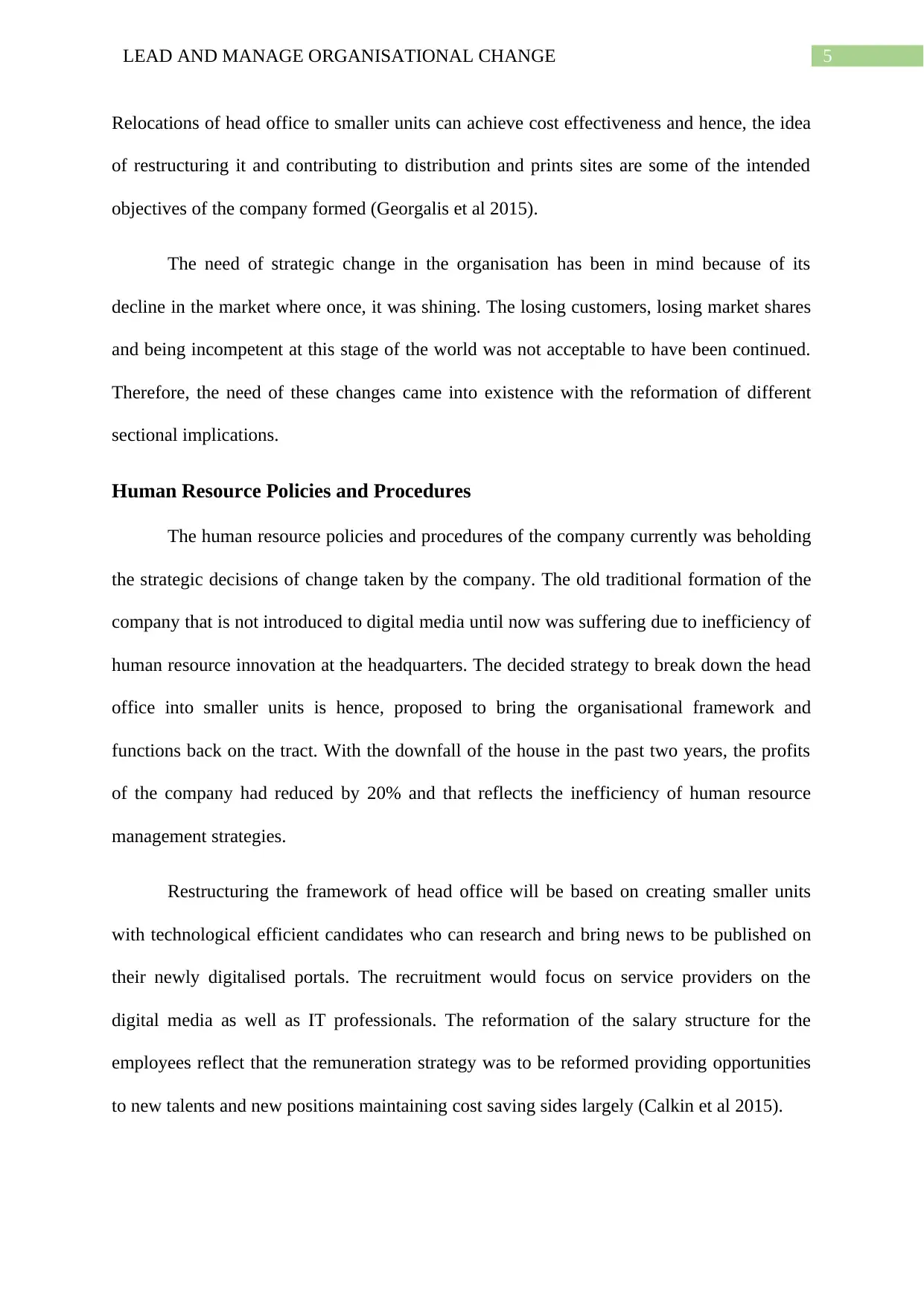
5LEAD AND MANAGE ORGANISATIONAL CHANGE
Relocations of head office to smaller units can achieve cost effectiveness and hence, the idea
of restructuring it and contributing to distribution and prints sites are some of the intended
objectives of the company formed (Georgalis et al 2015).
The need of strategic change in the organisation has been in mind because of its
decline in the market where once, it was shining. The losing customers, losing market shares
and being incompetent at this stage of the world was not acceptable to have been continued.
Therefore, the need of these changes came into existence with the reformation of different
sectional implications.
Human Resource Policies and Procedures
The human resource policies and procedures of the company currently was beholding
the strategic decisions of change taken by the company. The old traditional formation of the
company that is not introduced to digital media until now was suffering due to inefficiency of
human resource innovation at the headquarters. The decided strategy to break down the head
office into smaller units is hence, proposed to bring the organisational framework and
functions back on the tract. With the downfall of the house in the past two years, the profits
of the company had reduced by 20% and that reflects the inefficiency of human resource
management strategies.
Restructuring the framework of head office will be based on creating smaller units
with technological efficient candidates who can research and bring news to be published on
their newly digitalised portals. The recruitment would focus on service providers on the
digital media as well as IT professionals. The reformation of the salary structure for the
employees reflect that the remuneration strategy was to be reformed providing opportunities
to new talents and new positions maintaining cost saving sides largely (Calkin et al 2015).
Relocations of head office to smaller units can achieve cost effectiveness and hence, the idea
of restructuring it and contributing to distribution and prints sites are some of the intended
objectives of the company formed (Georgalis et al 2015).
The need of strategic change in the organisation has been in mind because of its
decline in the market where once, it was shining. The losing customers, losing market shares
and being incompetent at this stage of the world was not acceptable to have been continued.
Therefore, the need of these changes came into existence with the reformation of different
sectional implications.
Human Resource Policies and Procedures
The human resource policies and procedures of the company currently was beholding
the strategic decisions of change taken by the company. The old traditional formation of the
company that is not introduced to digital media until now was suffering due to inefficiency of
human resource innovation at the headquarters. The decided strategy to break down the head
office into smaller units is hence, proposed to bring the organisational framework and
functions back on the tract. With the downfall of the house in the past two years, the profits
of the company had reduced by 20% and that reflects the inefficiency of human resource
management strategies.
Restructuring the framework of head office will be based on creating smaller units
with technological efficient candidates who can research and bring news to be published on
their newly digitalised portals. The recruitment would focus on service providers on the
digital media as well as IT professionals. The reformation of the salary structure for the
employees reflect that the remuneration strategy was to be reformed providing opportunities
to new talents and new positions maintaining cost saving sides largely (Calkin et al 2015).
⊘ This is a preview!⊘
Do you want full access?
Subscribe today to unlock all pages.

Trusted by 1+ million students worldwide
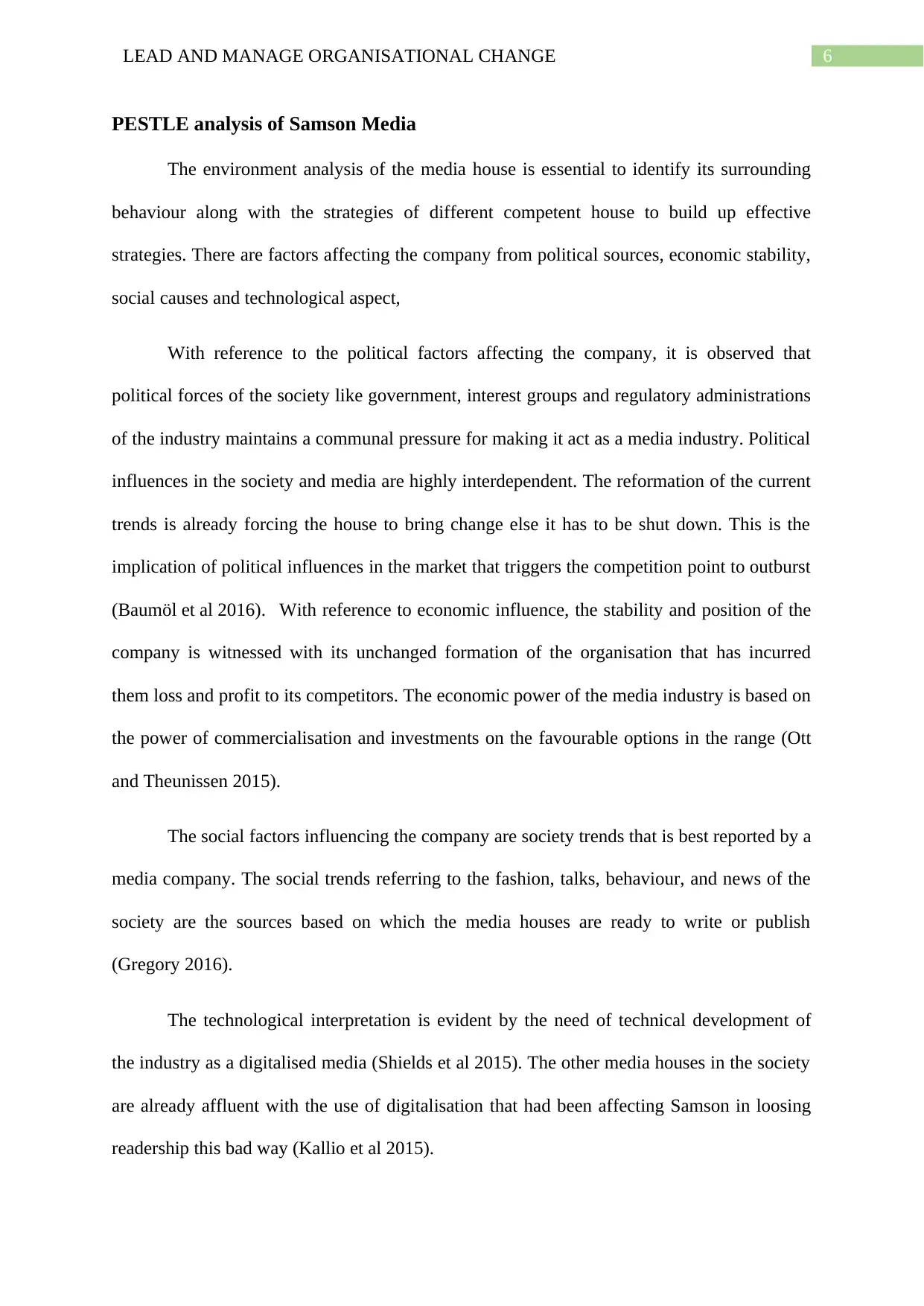
6LEAD AND MANAGE ORGANISATIONAL CHANGE
PESTLE analysis of Samson Media
The environment analysis of the media house is essential to identify its surrounding
behaviour along with the strategies of different competent house to build up effective
strategies. There are factors affecting the company from political sources, economic stability,
social causes and technological aspect,
With reference to the political factors affecting the company, it is observed that
political forces of the society like government, interest groups and regulatory administrations
of the industry maintains a communal pressure for making it act as a media industry. Political
influences in the society and media are highly interdependent. The reformation of the current
trends is already forcing the house to bring change else it has to be shut down. This is the
implication of political influences in the market that triggers the competition point to outburst
(Baumöl et al 2016). With reference to economic influence, the stability and position of the
company is witnessed with its unchanged formation of the organisation that has incurred
them loss and profit to its competitors. The economic power of the media industry is based on
the power of commercialisation and investments on the favourable options in the range (Ott
and Theunissen 2015).
The social factors influencing the company are society trends that is best reported by a
media company. The social trends referring to the fashion, talks, behaviour, and news of the
society are the sources based on which the media houses are ready to write or publish
(Gregory 2016).
The technological interpretation is evident by the need of technical development of
the industry as a digitalised media (Shields et al 2015). The other media houses in the society
are already affluent with the use of digitalisation that had been affecting Samson in loosing
readership this bad way (Kallio et al 2015).
PESTLE analysis of Samson Media
The environment analysis of the media house is essential to identify its surrounding
behaviour along with the strategies of different competent house to build up effective
strategies. There are factors affecting the company from political sources, economic stability,
social causes and technological aspect,
With reference to the political factors affecting the company, it is observed that
political forces of the society like government, interest groups and regulatory administrations
of the industry maintains a communal pressure for making it act as a media industry. Political
influences in the society and media are highly interdependent. The reformation of the current
trends is already forcing the house to bring change else it has to be shut down. This is the
implication of political influences in the market that triggers the competition point to outburst
(Baumöl et al 2016). With reference to economic influence, the stability and position of the
company is witnessed with its unchanged formation of the organisation that has incurred
them loss and profit to its competitors. The economic power of the media industry is based on
the power of commercialisation and investments on the favourable options in the range (Ott
and Theunissen 2015).
The social factors influencing the company are society trends that is best reported by a
media company. The social trends referring to the fashion, talks, behaviour, and news of the
society are the sources based on which the media houses are ready to write or publish
(Gregory 2016).
The technological interpretation is evident by the need of technical development of
the industry as a digitalised media (Shields et al 2015). The other media houses in the society
are already affluent with the use of digitalisation that had been affecting Samson in loosing
readership this bad way (Kallio et al 2015).
Paraphrase This Document
Need a fresh take? Get an instant paraphrase of this document with our AI Paraphraser
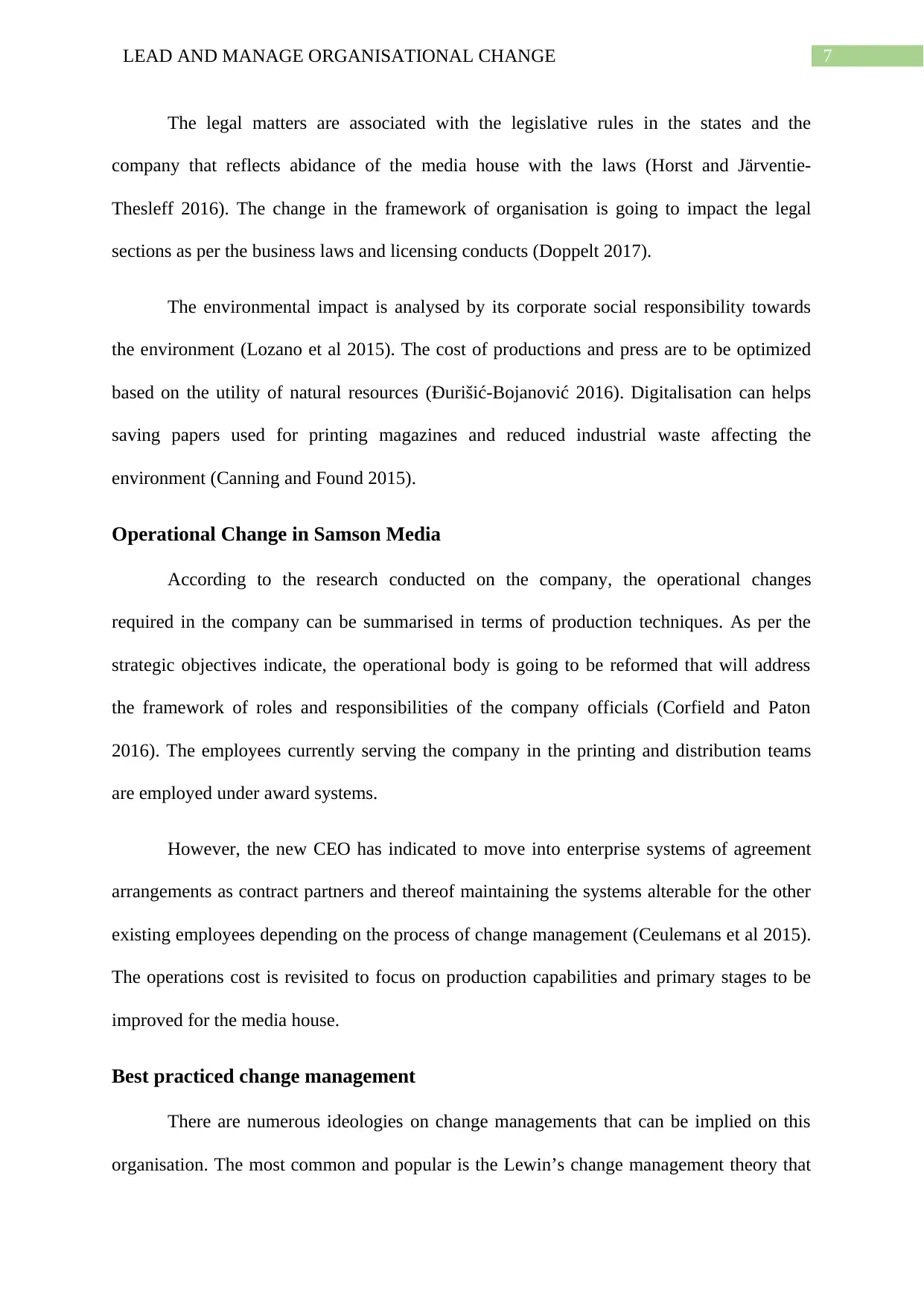
7LEAD AND MANAGE ORGANISATIONAL CHANGE
The legal matters are associated with the legislative rules in the states and the
company that reflects abidance of the media house with the laws (Horst and Järventie-
Thesleff 2016). The change in the framework of organisation is going to impact the legal
sections as per the business laws and licensing conducts (Doppelt 2017).
The environmental impact is analysed by its corporate social responsibility towards
the environment (Lozano et al 2015). The cost of productions and press are to be optimized
based on the utility of natural resources (Đurišić-Bojanović 2016). Digitalisation can helps
saving papers used for printing magazines and reduced industrial waste affecting the
environment (Canning and Found 2015).
Operational Change in Samson Media
According to the research conducted on the company, the operational changes
required in the company can be summarised in terms of production techniques. As per the
strategic objectives indicate, the operational body is going to be reformed that will address
the framework of roles and responsibilities of the company officials (Corfield and Paton
2016). The employees currently serving the company in the printing and distribution teams
are employed under award systems.
However, the new CEO has indicated to move into enterprise systems of agreement
arrangements as contract partners and thereof maintaining the systems alterable for the other
existing employees depending on the process of change management (Ceulemans et al 2015).
The operations cost is revisited to focus on production capabilities and primary stages to be
improved for the media house.
Best practiced change management
There are numerous ideologies on change managements that can be implied on this
organisation. The most common and popular is the Lewin’s change management theory that
The legal matters are associated with the legislative rules in the states and the
company that reflects abidance of the media house with the laws (Horst and Järventie-
Thesleff 2016). The change in the framework of organisation is going to impact the legal
sections as per the business laws and licensing conducts (Doppelt 2017).
The environmental impact is analysed by its corporate social responsibility towards
the environment (Lozano et al 2015). The cost of productions and press are to be optimized
based on the utility of natural resources (Đurišić-Bojanović 2016). Digitalisation can helps
saving papers used for printing magazines and reduced industrial waste affecting the
environment (Canning and Found 2015).
Operational Change in Samson Media
According to the research conducted on the company, the operational changes
required in the company can be summarised in terms of production techniques. As per the
strategic objectives indicate, the operational body is going to be reformed that will address
the framework of roles and responsibilities of the company officials (Corfield and Paton
2016). The employees currently serving the company in the printing and distribution teams
are employed under award systems.
However, the new CEO has indicated to move into enterprise systems of agreement
arrangements as contract partners and thereof maintaining the systems alterable for the other
existing employees depending on the process of change management (Ceulemans et al 2015).
The operations cost is revisited to focus on production capabilities and primary stages to be
improved for the media house.
Best practiced change management
There are numerous ideologies on change managements that can be implied on this
organisation. The most common and popular is the Lewin’s change management theory that
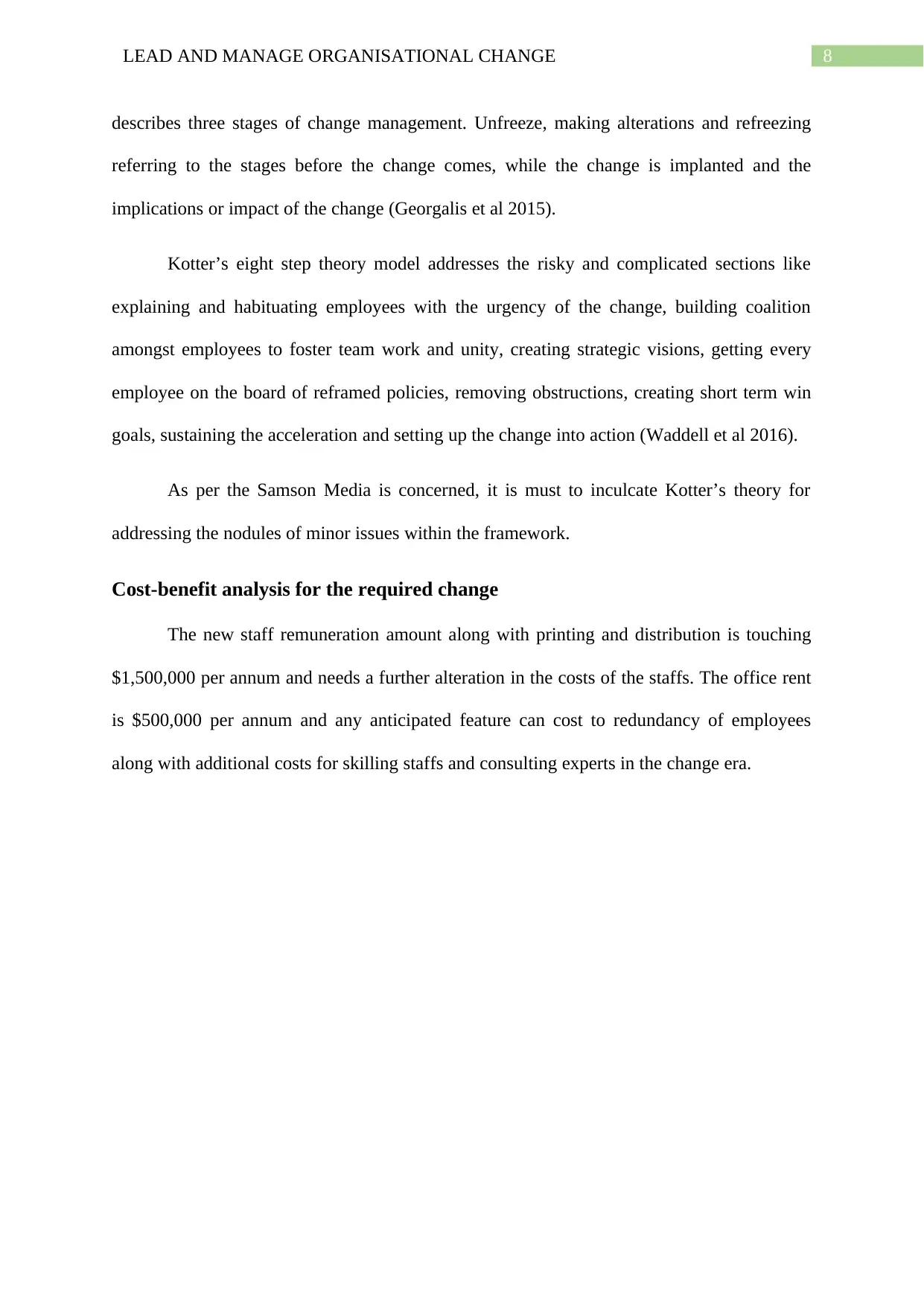
8LEAD AND MANAGE ORGANISATIONAL CHANGE
describes three stages of change management. Unfreeze, making alterations and refreezing
referring to the stages before the change comes, while the change is implanted and the
implications or impact of the change (Georgalis et al 2015).
Kotter’s eight step theory model addresses the risky and complicated sections like
explaining and habituating employees with the urgency of the change, building coalition
amongst employees to foster team work and unity, creating strategic visions, getting every
employee on the board of reframed policies, removing obstructions, creating short term win
goals, sustaining the acceleration and setting up the change into action (Waddell et al 2016).
As per the Samson Media is concerned, it is must to inculcate Kotter’s theory for
addressing the nodules of minor issues within the framework.
Cost-benefit analysis for the required change
The new staff remuneration amount along with printing and distribution is touching
$1,500,000 per annum and needs a further alteration in the costs of the staffs. The office rent
is $500,000 per annum and any anticipated feature can cost to redundancy of employees
along with additional costs for skilling staffs and consulting experts in the change era.
describes three stages of change management. Unfreeze, making alterations and refreezing
referring to the stages before the change comes, while the change is implanted and the
implications or impact of the change (Georgalis et al 2015).
Kotter’s eight step theory model addresses the risky and complicated sections like
explaining and habituating employees with the urgency of the change, building coalition
amongst employees to foster team work and unity, creating strategic visions, getting every
employee on the board of reframed policies, removing obstructions, creating short term win
goals, sustaining the acceleration and setting up the change into action (Waddell et al 2016).
As per the Samson Media is concerned, it is must to inculcate Kotter’s theory for
addressing the nodules of minor issues within the framework.
Cost-benefit analysis for the required change
The new staff remuneration amount along with printing and distribution is touching
$1,500,000 per annum and needs a further alteration in the costs of the staffs. The office rent
is $500,000 per annum and any anticipated feature can cost to redundancy of employees
along with additional costs for skilling staffs and consulting experts in the change era.
⊘ This is a preview!⊘
Do you want full access?
Subscribe today to unlock all pages.

Trusted by 1+ million students worldwide
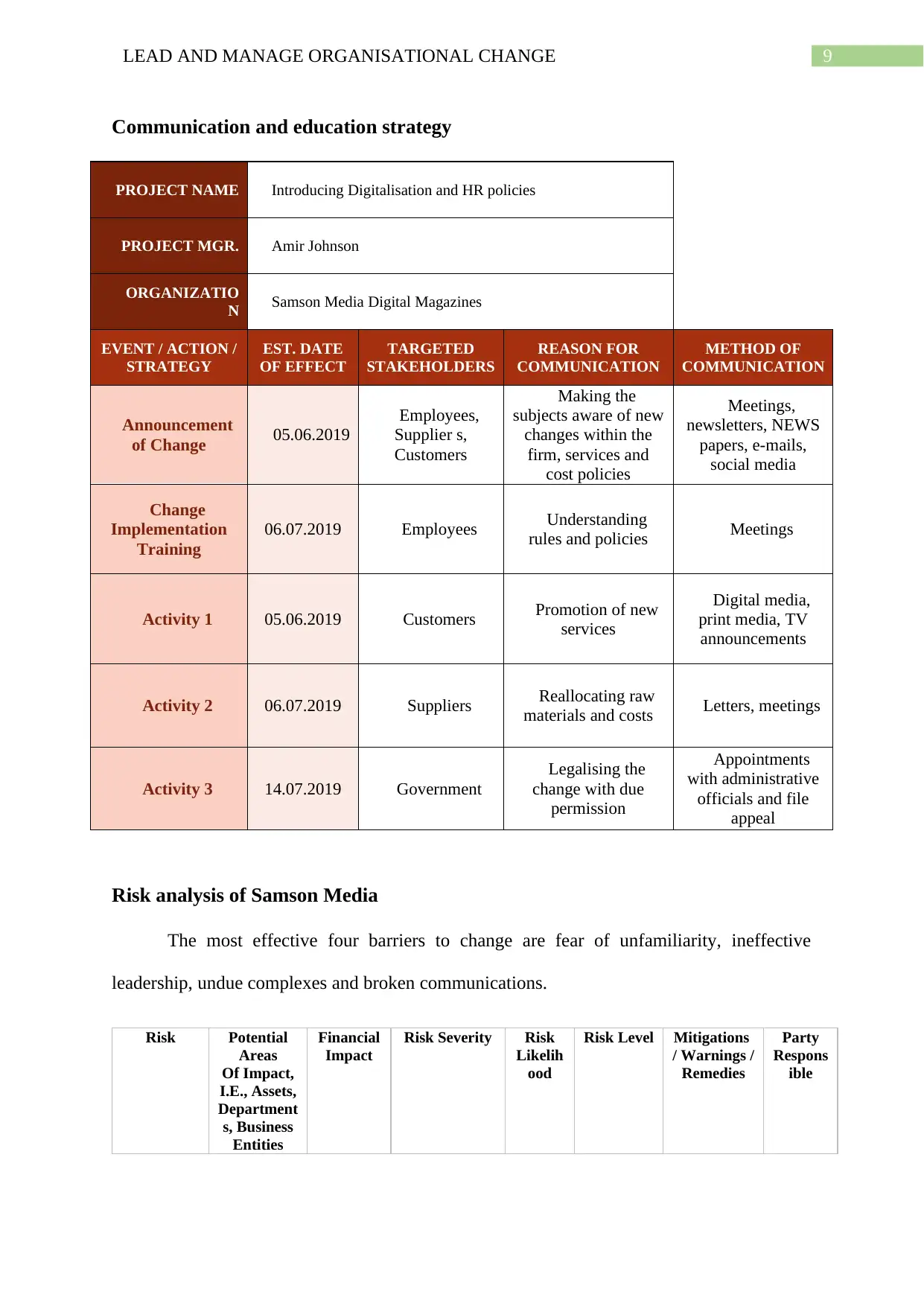
9LEAD AND MANAGE ORGANISATIONAL CHANGE
Communication and education strategy
PROJECT NAME Introducing Digitalisation and HR policies
PROJECT MGR. Amir Johnson
ORGANIZATIO
N Samson Media Digital Magazines
EVENT / ACTION /
STRATEGY
EST. DATE
OF EFFECT
TARGETED
STAKEHOLDERS
REASON FOR
COMMUNICATION
METHOD OF
COMMUNICATION
Announcement
of Change 05.06.2019
Employees,
Supplier s,
Customers
Making the
subjects aware of new
changes within the
firm, services and
cost policies
Meetings,
newsletters, NEWS
papers, e-mails,
social media
Change
Implementation
Training
06.07.2019 Employees Understanding
rules and policies Meetings
Activity 1 05.06.2019 Customers Promotion of new
services
Digital media,
print media, TV
announcements
Activity 2 06.07.2019 Suppliers Reallocating raw
materials and costs Letters, meetings
Activity 3 14.07.2019 Government
Legalising the
change with due
permission
Appointments
with administrative
officials and file
appeal
Risk analysis of Samson Media
The most effective four barriers to change are fear of unfamiliarity, ineffective
leadership, undue complexes and broken communications.
Risk Potential
Areas
Of Impact,
I.E., Assets,
Department
s, Business
Entities
Financial
Impact
Risk Severity Risk
Likelih
ood
Risk Level Mitigations
/ Warnings /
Remedies
Party
Respons
ible
Communication and education strategy
PROJECT NAME Introducing Digitalisation and HR policies
PROJECT MGR. Amir Johnson
ORGANIZATIO
N Samson Media Digital Magazines
EVENT / ACTION /
STRATEGY
EST. DATE
OF EFFECT
TARGETED
STAKEHOLDERS
REASON FOR
COMMUNICATION
METHOD OF
COMMUNICATION
Announcement
of Change 05.06.2019
Employees,
Supplier s,
Customers
Making the
subjects aware of new
changes within the
firm, services and
cost policies
Meetings,
newsletters, NEWS
papers, e-mails,
social media
Change
Implementation
Training
06.07.2019 Employees Understanding
rules and policies Meetings
Activity 1 05.06.2019 Customers Promotion of new
services
Digital media,
print media, TV
announcements
Activity 2 06.07.2019 Suppliers Reallocating raw
materials and costs Letters, meetings
Activity 3 14.07.2019 Government
Legalising the
change with due
permission
Appointments
with administrative
officials and file
appeal
Risk analysis of Samson Media
The most effective four barriers to change are fear of unfamiliarity, ineffective
leadership, undue complexes and broken communications.
Risk Potential
Areas
Of Impact,
I.E., Assets,
Department
s, Business
Entities
Financial
Impact
Risk Severity Risk
Likelih
ood
Risk Level Mitigations
/ Warnings /
Remedies
Party
Respons
ible
Paraphrase This Document
Need a fresh take? Get an instant paraphrase of this document with our AI Paraphraser
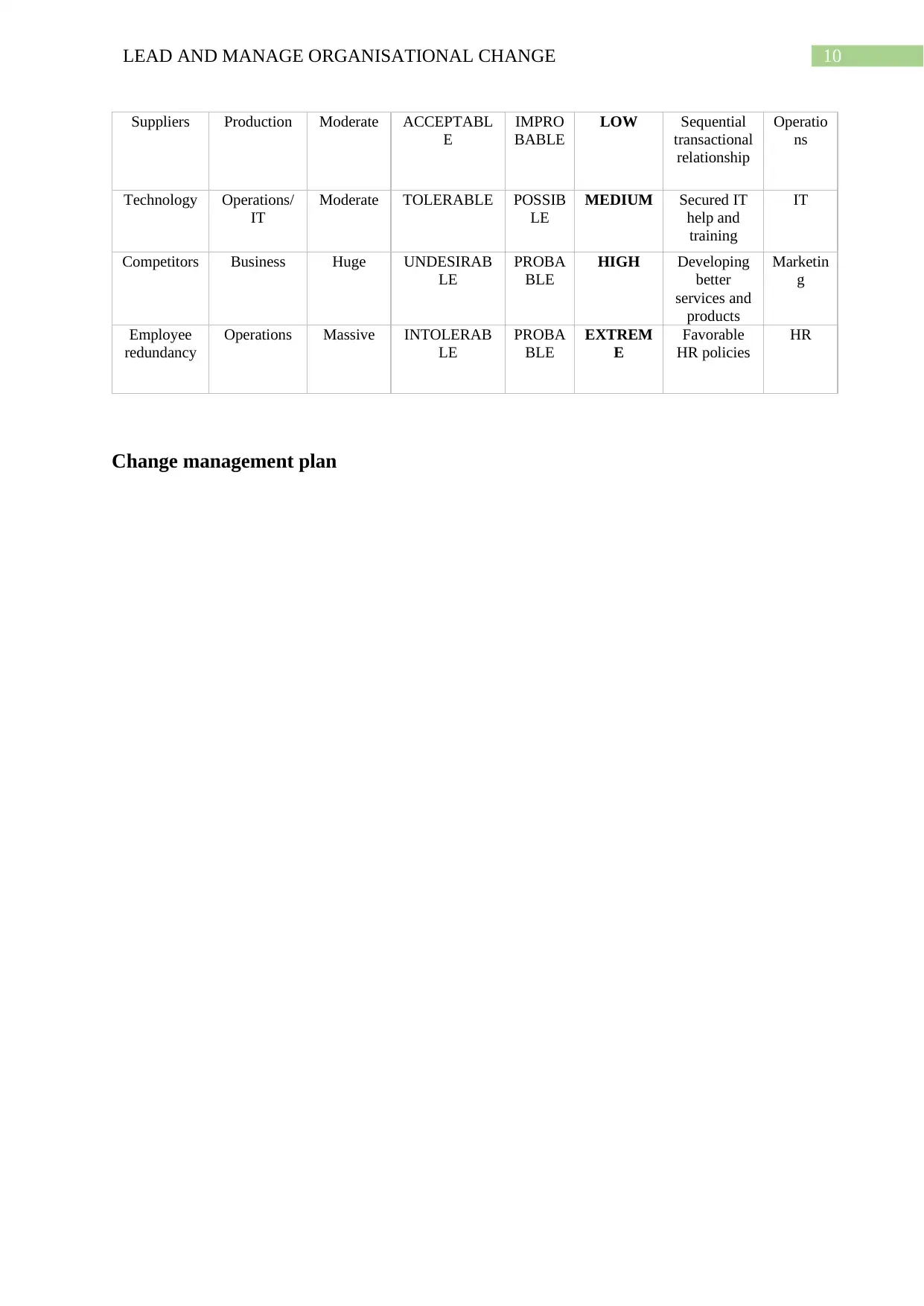
10LEAD AND MANAGE ORGANISATIONAL CHANGE
Suppliers Production Moderate ACCEPTABL
E
IMPRO
BABLE
LOW Sequential
transactional
relationship
Operatio
ns
Technology Operations/
IT
Moderate TOLERABLE POSSIB
LE
MEDIUM Secured IT
help and
training
IT
Competitors Business Huge UNDESIRAB
LE
PROBA
BLE
HIGH Developing
better
services and
products
Marketin
g
Employee
redundancy
Operations Massive INTOLERAB
LE
PROBA
BLE
EXTREM
E
Favorable
HR policies
HR
Change management plan
Suppliers Production Moderate ACCEPTABL
E
IMPRO
BABLE
LOW Sequential
transactional
relationship
Operatio
ns
Technology Operations/
IT
Moderate TOLERABLE POSSIB
LE
MEDIUM Secured IT
help and
training
IT
Competitors Business Huge UNDESIRAB
LE
PROBA
BLE
HIGH Developing
better
services and
products
Marketin
g
Employee
redundancy
Operations Massive INTOLERAB
LE
PROBA
BLE
EXTREM
E
Favorable
HR policies
HR
Change management plan
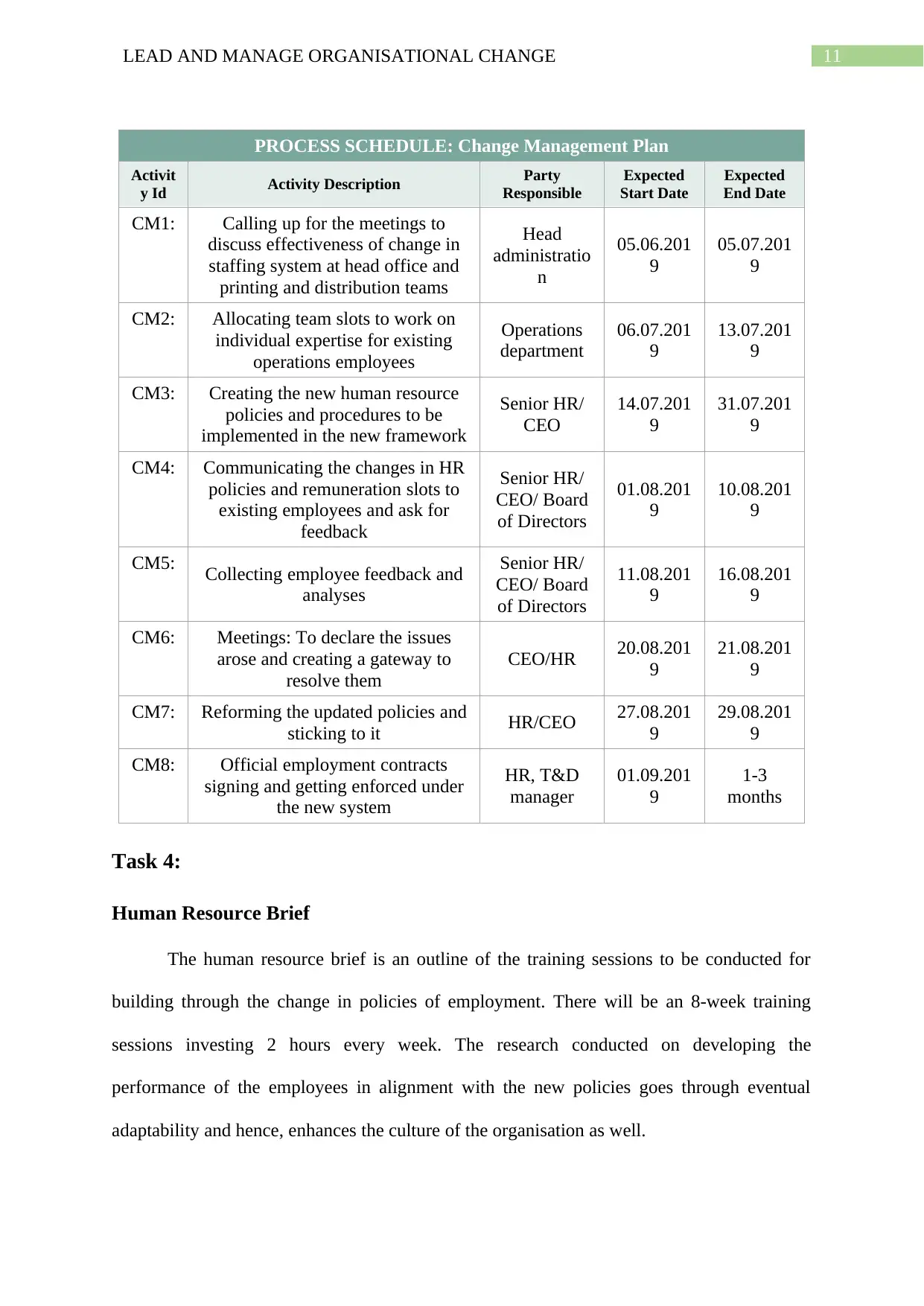
11LEAD AND MANAGE ORGANISATIONAL CHANGE
Task 4:
Human Resource Brief
The human resource brief is an outline of the training sessions to be conducted for
building through the change in policies of employment. There will be an 8-week training
sessions investing 2 hours every week. The research conducted on developing the
performance of the employees in alignment with the new policies goes through eventual
adaptability and hence, enhances the culture of the organisation as well.
PROCESS SCHEDULE: Change Management Plan
Activit
y Id Activity Description Party
Responsible
Expected
Start Date
Expected
End Date
CM1: Calling up for the meetings to
discuss effectiveness of change in
staffing system at head office and
printing and distribution teams
Head
administratio
n
05.06.201
9
05.07.201
9
CM2: Allocating team slots to work on
individual expertise for existing
operations employees
Operations
department
06.07.201
9
13.07.201
9
CM3: Creating the new human resource
policies and procedures to be
implemented in the new framework
Senior HR/
CEO
14.07.201
9
31.07.201
9
CM4: Communicating the changes in HR
policies and remuneration slots to
existing employees and ask for
feedback
Senior HR/
CEO/ Board
of Directors
01.08.201
9
10.08.201
9
CM5: Collecting employee feedback and
analyses
Senior HR/
CEO/ Board
of Directors
11.08.201
9
16.08.201
9
CM6: Meetings: To declare the issues
arose and creating a gateway to
resolve them
CEO/HR 20.08.201
9
21.08.201
9
CM7: Reforming the updated policies and
sticking to it HR/CEO 27.08.201
9
29.08.201
9
CM8: Official employment contracts
signing and getting enforced under
the new system
HR, T&D
manager
01.09.201
9
1-3
months
Task 4:
Human Resource Brief
The human resource brief is an outline of the training sessions to be conducted for
building through the change in policies of employment. There will be an 8-week training
sessions investing 2 hours every week. The research conducted on developing the
performance of the employees in alignment with the new policies goes through eventual
adaptability and hence, enhances the culture of the organisation as well.
PROCESS SCHEDULE: Change Management Plan
Activit
y Id Activity Description Party
Responsible
Expected
Start Date
Expected
End Date
CM1: Calling up for the meetings to
discuss effectiveness of change in
staffing system at head office and
printing and distribution teams
Head
administratio
n
05.06.201
9
05.07.201
9
CM2: Allocating team slots to work on
individual expertise for existing
operations employees
Operations
department
06.07.201
9
13.07.201
9
CM3: Creating the new human resource
policies and procedures to be
implemented in the new framework
Senior HR/
CEO
14.07.201
9
31.07.201
9
CM4: Communicating the changes in HR
policies and remuneration slots to
existing employees and ask for
feedback
Senior HR/
CEO/ Board
of Directors
01.08.201
9
10.08.201
9
CM5: Collecting employee feedback and
analyses
Senior HR/
CEO/ Board
of Directors
11.08.201
9
16.08.201
9
CM6: Meetings: To declare the issues
arose and creating a gateway to
resolve them
CEO/HR 20.08.201
9
21.08.201
9
CM7: Reforming the updated policies and
sticking to it HR/CEO 27.08.201
9
29.08.201
9
CM8: Official employment contracts
signing and getting enforced under
the new system
HR, T&D
manager
01.09.201
9
1-3
months
⊘ This is a preview!⊘
Do you want full access?
Subscribe today to unlock all pages.

Trusted by 1+ million students worldwide
1 out of 18
Related Documents
Your All-in-One AI-Powered Toolkit for Academic Success.
+13062052269
info@desklib.com
Available 24*7 on WhatsApp / Email
![[object Object]](/_next/static/media/star-bottom.7253800d.svg)
Unlock your academic potential
Copyright © 2020–2025 A2Z Services. All Rights Reserved. Developed and managed by ZUCOL.





